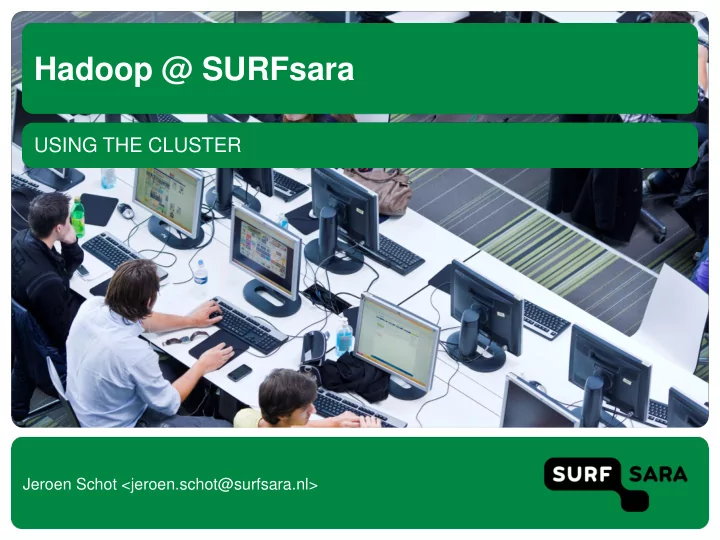

Hadoop @ SURFsara USING THE CLUSTER Jeroen Schot <jeroen.schot@surfsara.nl>
Overview - SURFsara in a nutshell - The SURFsara Hadoop cluster - How to use the cluster
About SURF
SARA SURFsara -Founded in 1971 as SARA by UvA, VU and CWI as shared data-processing facility. -Starting 1984 took the role as national supercomputing center. -Became an independent foundation in 1995. -Joined the SURF foundation as SURFsara in 2013.
Hadoop cluster -Started a test cluster in 2011 on six old machines -Real cluster in 2012: 60 machines: Hadoop 0.20, MapReduce, Pig -Now ~ 100 machines: Hadoop 2.6, MapReduce, Pig, Spark, Giraph, Tez, Cascading
Hadoop 1.0
Hadoop 2.0: YARN No longer just MapReduce: One ResourceManager (~ JobTracker) Many NodeManagers (~ TaskTracker) Job coordination is done by an ApplicationMaster (one per job) (Used to be the JobTracker)
Using the cluster - Command-line: from your own computer or our login node - Resource manager web-interface - Develop in your favorite IDE (Eclipse, IntelliJ) - Package your jobs as jar files - Submit the jar file using ‘ hadoop jar’ or ‘yarn jar’
Dependency management Your code probably depends on libraries. These libraries need to be available on the cluster machines. Multiple options: 1. Specify on command line: - yarn jar myjar.jar -libjars foo.jar,bar.jar 2. Bundle the jars inside the lib folder or your jar. 3. Extract all dependency class files (maven shade plugin) Build tools like maven, ivy and ant can help you with this. Example Maven POM-file (using method 2): http://beehub.nl/surfsara-hadoop/public/lsde-pom.xml You don’t need to include the Hadoop/MapReduce dependencies.
Step 1 – Login node Access via SSH: ssh lsdeXX@login.hathi.surfsara.nl (replace lsdeXX with your username) Optionally enable X-Forwarding for graphical applications: ssh -X lsdeXX@login.hathi.surfsara.nl
Step 2 – Interacting with the HDFS Use the ‘ hdfs dfs ’ command to access the distributed filesystem. Some common commands include: list contents of ‘ dir ’ hdfs dfs -ls dir hdfs dfs -rm file remove file hdfs dfs -cat file print file hdfs dfs -copyFromLocal src dest copy src on login node to dest on HDFS hdfs dfs -copyFromLocal src dest copy src on HDFS to dest on login node The full list can be found at http://hadoop.apache.org/docs/r2.6.0/hadoop-project- dist/hadoop-common/FileSystemShell.html
Step 3 – Submitting jobs (MapReduce ) jobs can be submitted using the ‘yarn jar’ command. This runs one of the standard jobs bundled with the Hadoop framework: yarn jar /usr/hdp/2.2.0.0-2041/hadoop-mapreduce/hadoop-mapreduce-examples.jar pi 10 10 Generally, you build your jar file on your desktop, use scp to copy it to the login node and use: yarn jar JARFILE MAINCLASS ARGUMENTS
Step 4 – ResourceManager web interface You can look at the progress of your job and the log files of individual process on the web interface of the ResourceManager. This can be accessed via ‘ firefox ’ started on the login node (X -Forwarding needed) You will need to change one setting in Firefox, see https://surfsara.nl/systems/hadoop/usage
Need help? Problems using the SURFsara Hadoop cluster? Contact either your course instructors or hadoop.support@surfsara.nl
Recommend
More recommend